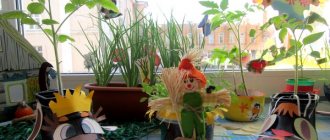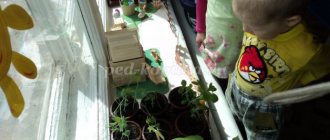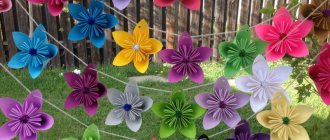Master class on decorating a vegetable garden on a window in the kindergarten “Dachka in Romashkovo”
This spring, according to tradition, our kindergarten held the “Vegetable Garden on the Window” competition.
They suggested an unusual topic - “The plot of my dreams.”
Since our group is called “Romashka,” our children from the preparatory group and I decided to call our garden plot “Dachka in Romashkovo.” We presented our dream dacha like this.
They built a two-story mansion (they took boxes as a basis, covered them with brick-like wallpaper, glued the windows, covered the roof with self-adhesive paper, made balcony railings from ceiling tiles and decorated the railings with trim made from egg cartons, and the foundation was made from shells).
In the vegetable garden area, a design approach was used: the arrangement of the beds and paving slabs is in the shape of the sun.
In the recreation area, flower beds were laid out, a gazebo was built, and a path made of shells was laid out.
We wanted trees to appear on our summer cottage, and we presented them in this form. To do this, we placed birch branches in the vase in advance so that they would produce leaves. The trunk was made from a paper cone, and a bottle of water was placed inside to prevent the branches from withering.
We paid great attention to creating the composition, and at the same time tried to present the variety of seedlings.
And this is our mini-laboratory. The children and I planted onions and observed their growth, and when they grew, we cut the greens and all ate them together with pleasure.
We observed the germination of bean and pea seeds (in cups). We watched the weather. We made notes in observation diaries.
We selected didactic games and coloring books for the children according to the topic, and held discussions on the topic. Then we planted our seedlings in the garden bed and watched the plants grow. At the end of summer we harvested beets, carrots, zucchini, peppers, but the fruits of our labor were shown to other kids, since our students had already become schoolchildren. I am sure that the knowledge and skills acquired in the process of such work will not pass without a trace.
Vegetables and berries that can be grown on the windowsill
cucumbers
Growing cucumbers on a windowsill in winter is a rather tempting prospect. This can be done not only by an experienced gardener, but also by a beginner. Cucumbers grow quite quickly; you can get the first harvest in just a month and a half.
Not every variety of cucumber is suitable for growing on a windowsill. Firstly, it must be self-pollinating. During flowering, the bush must be shaken daily for pollination to occur. Secondly, it will be much more convenient if the plant is a bush plant. Thirdly, an early variety is better suited for home growing.
Finally, a shade-loving plant is ideal. You can grow cucumbers on the windowsill in winter of the varieties Connie, Masha, Legend, Debut, Polet, Babylon. Knowing the necessary parameters, you can choose another variety.
Growing cucumbers at home has its own subtleties. After all, providing all the necessary conditions can be difficult. Cucumbers are light-loving, so windows on the south and east sides are suitable for growing them. If there is still not enough light, then additional illumination will be required using fluorescent lamps.
The room temperature should not be below 20 degrees, so you should not move flowerpots too close to a cold window. Cucumbers love moisture very much, so you need to make sure that the soil does not dry out. The flowerpot with the plant can be placed in a bowl of water. The leaves need to be sprayed with a spray bottle twice a day.
Tomatoes
Many people think that growing tomatoes on a windowsill is a very difficult task and inaccessible to a beginner. Moreover, there are special varieties for indoor cultivation.
When visiting a gardening store, note that some seed packages say “Recommended for pot growing”, “Window harvest”, “Home garden”. And the names of the varieties themselves are telling - Room Surprise, Balcony Miracle, Japanese Room. There are also hanging varieties that will look great in flowerpots - Peruvian Homemade, Cherry, Talisman.
Even if you don’t find special indoor varieties, regular ones will do. Please note that these tomatoes must be determinate (short, or better yet dwarf), self-pollinating (for pollination, the bushes are shaken during flowering) and small-fruited. For example, Alaska, Bonsai, Bonsai micro, Pearl (red and yellow), Canada News, Minibel, Pinocchio, etc.
Hot peppers
Pepper does not need additional lighting.
Sprouted seeds are planted to a depth of 1 cm and covered with film, and when shoots with several leaves appear, each plant is planted in a separate pot.
Peppers can bear fruit for five years.
Radish
For planting, choose large brown seeds, which are the most viable.
Radish can germinate on the third day; it likes cool temperatures, so the room should be ventilated more often.
Bell pepper
It is enough to plant this plant only once and it will delight you with a harvest throughout the year.
Sweet pepper is a very capricious crop, it does not like drafts and dark places, and requires loose soil and warmth.
Carrot
To grow at home, you need to take miniature varieties of carrots.
You can plant in boxes, pots or simply cut plastic bottles with holes in the bottom. The soil should be drained.
The seeds are placed in the ground to a depth of about 7 cm. When the carrots sprout and sprout a few centimeters, they need to be thinned out, leaving the strongest sprouts at a distance of about 2 cm from each other. It is not recommended to keep the beds in direct sunlight.
You need to water carrots at home often, but you need to make sure that there is not too much moisture, otherwise the root crop will rot. From time to time you can feed with fertilizers with a low nitrogen content (if there is a lot of it, all the growth will go into the tops). It is also very useful to loosen the soil from time to time.
Cherry tomatoes
Soil, as in the case of pepper, is more convenient to buy ready-made. It is recommended to take a cylindrical container: it is better filled with the root system.
First, the seeds are germinated in small pots: buried to a depth of 1.5 cm, covered with cling film and left in a warm place until the first sprouts. When the tomatoes have risen, they are dived into a larger and deeper bowl.
It is important that the plant receives even lighting. To do this, you can hang fluorescent lamps over the “beds” or regularly turn the containers towards the window.
Water carefully: it’s easy to overwater cherry tomatoes. When the plant grows, it is recommended to loosen the soil from time to time and feed it with mineral fertilizers. If necessary, the tomato trunk can be tied to a support (wooden skewer or pencil). It is also important to ensure that pests do not appear on the tomatoes.
Strawberry
For the home garden, ampelous remontant varieties of strawberries are suitable. They bear fruit all year round and are not too demanding of light. You can plant strawberries in any soil mixture. But first, drainage (expanded clay, small pebbles) should be poured onto the bottom to protect the strawberries from stagnation of water.
Strawberries can be grown from seedlings or seeds. Both are sold in gardening stores.
Seeds are planted in small containers (for example, plastic cups), watered generously and covered with cling film. After the first shoots appear, the film is removed and the seedlings are placed in a well-lit place. When three or four leaves are formed, the strawberries are dived into larger containers.
This plant loves light. When days are shorter than nights, artificial lighting should be used. Watering and spraying are carried out as the soil dries. Strawberries are easy to pour.
Solutions with a significant iron content are used as fertilizing. During active growth, the strawberry grows tendrils; they need to be tied to supports.
As you can see, growing vegetables, herbs and even berries in a city apartment is not difficult and even fun.
Mini-garden on the windowsill
Sections: Technology
Blizzards are playing out in the yard, and in the group, on the windowsill, spring is taking place. A mini-garden appeared here, bringing joy to everyone in the kindergarten, young and old. Window beds are not famous for their abundance, but for the possibility of live communication with plants. Anyone who starts such a vegetable garden will certainly become interested in experimentation and eco-design. In general, a mini-garden is a fun and useful activity.
I arranged the winter garden with great creativity: I designed it in the form of a farm, decorated it with suitable buildings and decorative accessories. A miller works at the mill, the housewife manages the garden, a scarecrow guards the crops, butterflies, birds and bees delight the eye. In honor of these workers, I named my mini-vegetable garden “Bee”.
The windowsill is a great place for growing a small home garden. The process of growing fresh herbs on a window is simple and requires almost no material costs, but it is so much fun and beneficial. You can grow a significant range of crops on windows: greens, legumes, root vegetables that bloom right on the window (carrots, beets, potatoes), aromatic herbs.
Why do you need a vegetable garden on the window? When garlic, onions, cucumbers, and lemon live on the window, their variety of colors pleases and relieves stress. In addition, they not only warm the soul, but are also good for health. If garlic grows indoors, you will forget what the flu is.
Growing vegetables in kindergarten is also beneficial because it develops curiosity and observation in children, helping them to better understand the life of plants. Methods for observing plants should be selected taking into account the age of children and their individual characteristics. Growing something from a seed will be interesting even for the smallest children; you can even measure the sprouts every day with a ruler and record the data obtained in a specially designed book for observations.
How to arrange a vegetable garden on a windowsill? What might this require? First of all, the desire to do all this! And also:
- Containers.
- Priming.
- Watering can, spray bottle, scoops of different sizes.
- Aprons, gloves.
- Seeds.
- Decor items and a little imagination.
Currently, aromatherapy is very popular, I propose to arrange a fragrant bed on the windowsill, on which you can easily grow:
Green onions. It is better to plant it in the ground. This way the onions will produce crops all winter. If you decide to follow your grandmother’s experience and set up a “water” garden, change the water once a day. This way the onions will not rot and will not give off an unpleasant odor.
Dill. Fragrant herb is a spice known to everyone. Dill requires sun and warmth. Once a week you need to loosen the soil. Goes well with parsley.
Parsley. This young lady tolerates cold well and loves humidity very much. Grows on a windowsill in winter, provided it gets enough sunlight.
Your windowsill will be perfectly decorated with decorative parsley (curly).
Basil. This excellent seasoning grows quietly on the windowsill and does not require any special care. Decorative basil will look luxurious on the windows; purple plants are the most fragrant. For asthmatics, basil makes breathing easier, and for those who eat it regularly, it protects them from stress.
Arugula. Popular salad herb. It sprouts almost instantly, and after 20 days you can eat. It loves the sun very much, so it requires artificial lighting.
Rosemary. Amazing seasoning. It grows in a flowerpot for years; only in the summer, if possible, plant it in the garden. The fragrant bush is very useful and is used as a seasoning.
Mint. My favorite aromatic herb. Do you know how delicious it is to drink mint tea with lemon in winter? Water this bush regularly and a calming aroma will settle in your group.
A collection of seeds, collected in a decorated box, helps introduce children to the variety of seeds and vegetable crops. The collection is available for children, they act with the seeds as they wish (look at, smell, sow, water and observe).
Well-groomed vegetable crops in neat dishes look elegant and go well with most decorative indoor plants. They decorate the room and can provide aesthetic pleasure.
Each of us strives to create a pleasant environment around us, filling it with our favorite aromas. To do this, you can use what nature itself provides: flowers, herbs, spices, seeds. I use what I managed to grow myself: herbs, dried flowers, plant seeds.
All plants have magical properties, have positive energy and cleanse rooms from harmful influences. Since ancient times, the tradition of sewing herbs into fabric has been passed down to give clothes and linen a pleasant aroma and protect them from bad influences. Later, to prevent dry plants from scattering, they began to sew fabric bags in which various herbs were mixed. The aromatic bags are called sachets; they can have different shapes (heart, bag, fruit, pillows).
Nowadays, the sachet serves as a source of freshness and decoration for the home, office, and car.
DIY sachets can act as herbal amulets.
How to make a vegetable garden on a windowsill: plants for beginners and design ideas
The dream of a year-round summer cottage is more than real; make garden beds right in your apartment - on the kitchen window.
You can build a beautiful vegetable garden on your windowsill with your own hands at any time of the year - the main thing is to choose the right plants. If you want to admire greenery all year round, consider combinations of crops, ripening order and regularly add new seedlings. Find out what is best to plant at home and how to beautifully decorate a mini-garden in the kitchen.
- Equipment for growing indoor vegetables and herbs
- What can you grow in a garden on a windowsill?
- Fresh herbs all year round
- Vegetables for decoration and salads
- Unusual crops for indoor growing
- A children's garden is an interesting way to teach a child to work
- How to increase vegetable yields and speed up the growth of greenery
- Ideas for original design of a vegetable garden on a window
Equipment for growing indoor vegetables and herbs
First of all, think about containers for planting plants. It all depends on what you want to get - a decorative mini-vegetable garden for decoration or just a harvest. For the first option, come up with a design based on the photos suggested in the section below. For the second, almost any container is suitable:
- ceramic or plastic pots of various configurations;
- containers for seedlings (for annuals you can even take peat ones);
- plastic bowls;
- glass jars;
- ceramic mugs;
- deep trays (for greens);
- all kinds of packaging;
- disposable tableware.
For fast-growing greens, you can use short-lived containers, but for plants that will grow for a long time, choose high-quality containers. If the pot is ugly or old, look at the options and ideas for decorating the pots with your own hands.
To care for garden pets on the windowsill, buy a spray bottle for spraying plants, a small watering can, and scissors for trimming fruits and herbs.
If the arrangement will be decorative, look for kits for caring for potted crops, including miniature spades, rakes and other tools. Such equipment will decorate a toy mini-dacha.
To create greenhouse conditions that increase and accelerate seed germination, use plastic caps or bags.
What can you grow in a garden on a windowsill?
Small plants with a compact root system can be grown in window beds. These are tomatoes and cucumbers of certain varieties, sweet and hot peppers, herbs and some other vegetables and fruits. If you don’t want a vegetable garden, make an exotic garden of dwarf lemons and tangerines. If you have no space at all, create a mini-garden in a pot.
Fresh herbs all year round
Greens for growing in an apartment all year round can be bought in specialized stores. Carefully study the label: ripening period, sowing and care features.
The simplest greens for an indoor mini-vegetable garden are watercress . This is a spicy herb of a delicate green, bluish or yellowish hue. The taste of young leaves, depending on the variety, is similar to mustard, radish or horseradish. Watercress is rich in vitamins, invigorates and strengthens the immune system. Young shoots are eaten. The seeds germinate quickly, and after a couple of weeks you can harvest them by cutting them with scissors.
Dill is a traditional green. For growing dill on a windowsill, abundantly leafed varieties that do not throw away the umbrella for a long time are suitable. It is better to choose mid-ripening species, since early ripening ones lose their attractiveness faster.
Parsley is the favorite and most sought after spice in the kitchen. In the garden on the kitchen windowsill you can grow almost all types of leaf parsley with your own hands. Curly, low varieties look beautiful.
Basil attracts with its strong spicy aroma and original taste. Low-growing and decorative varieties, for example, “osmin”, “marquise”, “dwarf”, are suitable for growing on the window. They grow quickly and look neat.
onions on the windowsill in early childhood, using a jar of water. This method cannot be called decorative; moreover, the jars take up a lot of space. For growing in pots from seed, look for fast-maturing varieties. Chives are good to eat, they are beautiful, have a delicate aroma and quickly please you with the result.
Mint fills the room with a soothing aroma, and its leaves are added to tea and various dishes. Mint is a perennial plant; once you plant it, you don’t have to think about planting again for a long time. For a bush to look beautiful, it needs to be shaped correctly. Compact varieties for growing in pots: pennyroyal, pearl, ceremony.
To make your garden on your windowsill useful, learn how to grow sorrel, rosemary, savory, and lemon balm in winter. Feel free to plant oregano, cilantro, thyme, and stevia.
Vegetables for decoration and salads
You shouldn’t count on a rich harvest of vegetables for homemade preparations. But the miniature fruits are pleasing to the eye and ideal for table decoration.
Cucumbers are a classic of the dacha genre. Self-pollinating hybrids are the best varieties of cucumbers for growing on a windowsill, otherwise you will have to pollinate the flowers by hand. If your windows face north, look for shade-loving views. For an apartment garden we recommend:
- “Rytov’s room”;
- early ripening "Masha f1";
- “Prestige f1” with long-lasting yield;
- “balcony”, suitable for loggias and balconies.
Cucumbers love space, so choose a free container - one seedling needs about five liters of volume. Cucumbers need light and warmth; it is especially important to neutralize the lack of natural phenomena in winter.
To beautifully arrange a vegetable garden on a windowsill, it is important to form the bush correctly, providing high support. Be sure to pinch the vine and remove the tendrils so that the plant does not waste energy on them and bears fruit faster.
Tomatoes are an ideal plant for a mini-garden in an apartment. To grow tomatoes on a windowsill, look for dwarf varieties with small fruits. Tomatoes collected in bunches look beautiful. Suitable varieties:
- “minibel” about 30 cm high;
- precocious “balcony miracle”;
- fragrant “balcony red” “micro bonsai”, growing only up to 15 cm;
- easy to care for "Pinocchio".
Place pots of tomatoes on lighted windows, use additional lighting so that the photoperiod is 13-16 hours a day. Avoid drafts and watering with cold water. It takes a long time to grow from seeds; it’s easier to buy ready-made seedlings.
Pepper is a favorite of “window gardeners.” On windowsills, as in ordinary gardens, sweet and bitter varieties of pepper are grown. Breeders have developed small varieties that are ideal for the kitchen and do not require complex care. Among them there are fruit and ornamental species with fruits of different shapes and shades.
This crop is easy to grow from seeds even for a beginner - we have detailed instructions on growing indoor peppers, take them into account.
Unusual crops for indoor growing
What else can you grow on the windowsill in winter, spring, summer and autumn to enjoy and decorate your home?
- Ginger is easy to obtain from the root - place it in warm water for several hours for buds to germinate. Plant it in a pot
- Strawberries of decorative hanging varieties bear fruit in the apartment even in winter. It is important not to forget to pollinate flowers with your own hands.
- Strawberries are not so easy to grow in a window, but strawberry plantations grow very beautifully.
- Radishes are characterized by rapid germination, love coolness and regular watering.
- Mushrooms in an apartment can also be grown on the windowsill; oyster mushrooms are ideal for such a garden.
A children's garden is an interesting way to teach a child to work
To distract your child from the computer, build a mini-dacha with him on the window in his room or kitchen.
To make a children's garden on the windowsill for beginners, which the child will later do independently, choose pets that do not require complex care and a lot of time. Ideally, plants should:
- grow quickly, otherwise the baby will get tired of waiting for results;
- it is easy to tolerate the lack of watering - the child may forget about care, but will be very upset if the pets dry out;
- To be beautiful and interesting in development, it is good if a son or daughter can observe the various cycles of ripening - from germination to flowering and harvesting.
Don't plant too many plants, focus on decoration. For kids, you can come up with a little fairy tale with a hut and characters who will take part in caring for and harvesting the harvest.
The most childish plant is watercress; its rapid germination inspires further experiments. Children really like small tomatoes and citrus fruits with mini fruits. It is better to avoid hot pepper so that the temptation to taste the harvest does not end in tears.
How to increase vegetable yields and speed up the growth of greenery
In order for vegetables and herbs grown on the windowsill to feel like they are in the beds of a full-fledged garden, you need to create all the necessary conditions for them.
- Try to provide a separate container for each type of plant. Different crops have their own requirements for soil, watering, and free space for roots.
- Good soil - do not skimp on soil and do not collect soil in the park or city flower beds. Buy a package of soil in a store; such soil has everything necessary for the development of crops. To grow annuals, you don’t even have to resort to fertilizer.
- Ensure good drainage - excess moisture harms roots just as much as drought.
- To make the seedlings germinate faster, pre-soak and germinate the seedlings. After planting in moist soil, cover with a plastic cap. Look for a detailed germination diagram on the seed package.
- Additional lighting is an important point in the winter season, when daylight hours cannot provide plants with the required amount of light. For illumination, it is best to use special phytolamps that emit the light spectrum necessary for photosynthesis. If there are none, make LED lighting - it is economical and not dangerous for delicate leaves.
- Spraying with water is an important part of success. The air in the room, and especially on the window above the radiator, is dry, so regularly create artificial precipitation for your green pets.
Ideas for original design of a vegetable garden on a window
Most plants like it in the kitchen - it's warm and humid all year round. Pots are always in front of your eyes, which means you won’t forget about caring for them.
Of course, you can simply grow herbs and vegetables in ordinary flower pots, the taste and benefits will not change in any way, but why not turn a mini-garden into a fairy tale by playing with the composition in an interesting way.
Drawing ideas for decorating a vegetable garden on a windowsill in the photo, do not be afraid to add your own additions and highlights to the design. You can first draw a diagram, indicating on it the arrangement of crops and decorative elements - a fence, a house, benches, stairs, animal figures.
When creating mini-beds, do not forget to take into account the possibility of the proximity of different crops. For example, cucumbers and tomatoes require different air humidity, so you should not grow them in close proximity.
To place more containers on the window, use racks, shelves and hanging shelves. They are convenient for low-growing specimens and greenery.
A miniature vegetable garden decorates the kitchen in winter and summer, and organic greens can be added to soups and salads. It is very convenient when you need just a few parsley leaves for broth or a mint leaf for tea.
This hobby is very exciting and does not take much time, like a real dacha or a decorative vegetable garden on a personal plot. If you are interested in decorating the composition, the kitchen will become more comfortable, and guests will have something to show.
Planted a vegetable garden, look what grows!
Look what's growing!
We will look after
Let's go for the sprouts
On March 2, the traditional competition “Mini-garden on the window” was held at the Moscow Regional Administrative Educational Institution No. 158 in the city of Tyumen. There is still snow outside the window, and in every age group there is a green vegetable garden on the window sills. How much imagination, imagination and creativity the teachers and parents put into it! To make the mini-garden attract the attention of children, various themes were used. This is how the plot from the fairy tale “Kolobok”, a village courtyard, the family of the funny “Cipollino”, a ship with small boats and much more appeared.
We are very glad that parents responded with great desire to help with gardening in groups. Using their skills, the parents tied the jars, giving them the appearance of funny little people, sewed and filled nylon animals with oats: bears, frogs, mice, squirrels, etc., turned plastic bottles into boats, built a wonderful village house, wove wickerwork with sunflowers etc. The vegetable gardens turned out to everyone’s surprise, just a sight for sore eyes!
We are very glad that parents responded with great desire to help with gardening in groups. Using their skills, the parents tied the jars, giving them the appearance of funny little people, sewed and filled nylon animals with oats: bears, frogs, mice, squirrels, etc., turned plastic bottles into boats, built a wonderful village house, wove wickerwork with sunflowers etc. The vegetable gardens turned out to everyone’s surprise, just a sight for sore eyes!
Children look after and observe the planting of garden and flower crops, and then in the album “We planted a vegetable garden, what grows in it?” make sketches of planted vegetable and grain crops: beans, peas, beans, carrots, beets, parsley, their seeds and root crops grown, potatoes, tomatoes, oats, wheat, etc.
The photo report was prepared by: Marina Viktorovna Krapivina, deputy head of the Medical Educational Institution No. 158 of the city of Tyumen
No wonder winter is angry,
Spring is knocking on the window
And he drives him out of the yard...
Pupils of MADOU kindergarten No. 118 in the city of Tyumen felt the arrival of spring in all its glory!
The creative teaching team did their best for the children! Poplar and birch trees have put out their leaves on the window sills in the group rooms. In the gardens created by the hands of teachers and children, dill and peas sprouted. Children with great pleasure replenish their supply of vitamins with green onions grown by themselves!
“Village Compound” - teacher Popova E.L.
“At Masha and the Bear” - teacher Zlobina N.V.
“Vegetable garden all year round” - teacher Shustova A.G.
“Pleten” – teacher Galimova M.I.
Photo report prepared by: Elena Vasilievna Suetina, Deputy Head of Education and Resource Management of the Medical Educational Institution, Kindergarten No. 118, Tyumen
MAOU Byzovskaya primary comprehensive school, department of preschool education (Uporovsky district)
After looking at the information about the photo exhibition “Planted a vegetable garden, look what’s growing!”, the teachers of our small kindergarten, O.N. Medvedeva and L.A. Zhenikova, decided to decorate their vegetable gardens on the window, and this is what they came up with.
Senior teacher T.V. Smagina
In March 2012, the project “Vegetable garden on the windowsill” was held at the kindergarten No. 59 in the city of Tyumen. In each age group, “vegetable gardens” were created where children could observe the growth of plants.
Target:
To generalize and expand the knowledge of preschoolers about how to care for plants indoors; involve as many children as possible in the project; make the project a co-creation of the teacher, children and parents.
Results:
video clip from the teacher of kindergarten No. 59 in Tyumen, Larisa Mikhailovna Koksharova
Author of the photo report: Deputy Head of the Ministry of Internal Affairs of MADOU d/s No. 59 of the city of Tyumen, Bagaeva Tatyana Nikolaevna
We invite teachers of preschool education in the Tyumen region, Yamal-Nenets Autonomous Okrug and Khanty-Mansi Autonomous Okrug-Yugra to publish their teaching materials: – Pedagogical experience, original programs, teaching aids, presentations for classes, electronic games; – Personally developed notes and scenarios of educational activities, projects, master classes (including videos), forms of work with families and teachers.
Why is it profitable to publish with us?
1. 1. “Kindergartens of the Tyumen Region” is an officially registered specialized media outlet at the federal level. EL No. FS 77 – 43321 2. The activities of the editorial office are supported by the Department of Education and Science of the Tyumen Region 3. We issue a “Certificate of Publication” in the media. 4. The document has a unique number, is entered in the register, has the original seal of the editorial office of the online publication and signature. 5. “Certificate of publication” in the media is sent to the author in both paper and electronic versions. In detail In detail >>> Sample “Certificate of publication of author’s methodological material in the media”.pdf
From the editors of the online publication “Kindergartens of the Tyumen Region” All authors of reports in the “Preschool News” section, which are published under an editorial agreement with a preschool educational institution, can order a Sample “Certificate of publication in the media.”pdf Go to the order form >>>
If you are a preschool teacher in the Tyumen region, Yamal-Nenets Autonomous Okrug or Khanty-Mansi Autonomous Okrug-Yugra, you can publish your news material. Apply for a one-time publication of a report, registration and sending of a “Certificate of Publication in the Media”. (Paper or electronic version).
At the end of the academic year, the editors select the most successful works and, together with the Department of Education and Science of the Tyumen Region, encourage the authors with valuable gifts and letters of gratitude.
Consultation and advice for educators “Organizing a vegetable garden on the window”
Olga Fedorovskaya
Consultation and advice for educators “Organizing a vegetable garden on the window”
The influence of the surrounding world on the development of a child is enormous. Acquaintance with endless, constantly changing phenomena begins from the first years of a child’s life. Natural phenomena and objects attract children with their beauty, bright colors, and diversity. By observing them, the child enriches his sensory experience, on which his further creativity is based. The more deeply a child learns about the mysteries of the world around him, the more questions he has. The main task of an adult is to help the child find answers to these questions on his own. In order to satisfy children's curiosity, instill the first skills of activity and independent thinking, conditions are created for children's search and research activities, which contributes to the formation of aesthetic perception , a sense of beauty and a humane attitude towards nature in children.
Children will be convinced that a garden on the window , made with their own hands, will provide tasty and fresh vegetables and herbs grown by them, which are not only tasty, but also healthy, since they do not contain any chemicals.
A children's garden on the window will give great pleasure, beauty and great health benefits. Moreover, the process of caring for and growing a vegetable garden is very exciting and interesting. With the joint efforts of children and teachers , you can create a beautiful and tasty harvest on the window .
A vegetable garden on the window is a kind of “vitamin oasis.” In fact, such a wonderful idea can be implemented very simply and quickly.
Such knowledge will allow little gardeners the garden on the window with even greater interest .
Remember that the window where the garden will be placed is better to face the sun.
Choosing the design of the future vegetable garden on the window .
It’s very easy to create a garden design on , the main thing is imagination.
brightly decorated vegetable garden will look fun and unusual, and will delight everyone with its attractive appearance.
It is very important to provide proper lighting for the garden , optimal temperature and humidity. But this is not all the requirements for successful growth.
Good and high-quality soil, thanks to which the plants will bear fruit, must be correctly selected.
Useful tips for favorable flowering of a mini-garden on the window :
1. Sow the seeds of your favorite crops evenly.
2. Caring for a vegetable garden on a window is not very difficult, the main thing is to water it systematically.
3. The temperature for plants should be above 17 degrees, otherwise the plants will rot and not bear fruit.
4. The window where the vegetable garden must be carefully sealed and not allow drafts to pass through.
5. For climbing plants, it is necessary to create a special design .
6. Choose plants for the window garden so that they are adapted to the room and are not too whimsical.
A vegetable garden on the windowsill in a kindergarten promotes the development of curiosity and observation in children, this helps to better understand plant life. He is able to expand children's ideas about plants as living organisms , about the conditions necessary for growth and development, develop an aesthetic sense, the ability to enjoy the beauty of the plants grown and the results of their work.
Such a children's garden will perfectly decorate the interior, and the environmentally friendly and always fresh fruits will never cease to please the children all year round.
Especially such a garden will be very useful in the winter season, when the amount of vitamins is limited.
In order to decorate a vegetable garden on the window , educators need to apply their creativity and involve parents in the design.
Grow a vegetable garden with your children and eat the fruits with pleasure!
Use of ICT in the pedagogical process. Advice for beginning educators Individual professional development plan for teachers; formation of their own professional ICT competencies; creating your own.
Consultation for teachers “Organization of conditions for design and artistic work” Organization of conditions for design and artistic work. For construction in all age groups, small (table) is used.
Consultation for parents “Left Hand Drive!” Advice for parents whose children are left-handed Slavik D.’s mother came up to me in the group and asked: “If my boy is left-handed, is he somehow “wrong”? I explained that I am left-handed.
Consultation for educators on the topic: “Organization of a play environment in the younger group” Municipal budgetary preschool educational institution “Kindergarten of a general developmental type No. 36” of the urban district of the city of Salavat of the Republic.
Master class “A well for a vegetable garden on the window” Master class. A well made of clothespins. Materials: wooden clothespins, ice cream sticks, wooden skewers, twine, glue gun. Decorating a vegetable garden on the window in the middle group. These are the fellows who planted cucumbers, onions, carrots and peas. Our garden is ready! Let's all water the harvest and wait together! In our average.
Useful tips for educators in working with children with mental retardation Dear colleagues! The most pressing problem is the problem of raising and educating children with mental retardation (MDD). Quantities.
Planting seeds and growing a “vegetable garden on the window” (senior and preparatory groups) Planting seeds and growing a “vegetable garden” on the window. Senior preparatory group. Educational objectives: Development of children's thinking and imagination.
Advice for educators “Labor education of preschoolers” When a child enters life, he makes discoveries for himself every day, masters knowledge, skills, and abilities. Don't rush him, don't urge him on with shouts, no.
Source
Vegetable garden on the window in a kindergarten: decoration in the form of a fairy tale, photo
Children spend most of their time in preschool. In part, this is their second home. Through the efforts of teachers, children learn a lot of new things during the day. For greater variety and interest, the program includes creative projects. A vegetable garden on a window in a kindergarten, decorated in the form of a fairy tale, is one of them. Available tools, patience and imagination will help bring ideas to life.
Where to begin?
First of all, if you decide to develop such a gardening project in a kindergarten, then you must become familiar with the safety rules. You can take part in the offline webinar “General safety rules when working with gardening equipment” (volume 2 hours). Obviously, you are by no means a future gardener, but you can learn a lot and then have a conversation with your children.
After all, if you extend the project to the entire garden, then you also need to cover the junior and middle groups. They can make primitive versions of mini-flower beds on the windowsill. But we will take on the older group more actively.
So, what ideas can I suggest? Of course, the garden theme is most relevant in the spring and summer, but if it is sunny winter or autumn, then there is a chance that your vegetable garden on the windowsill will function all year round. The main thing is to choose unpretentious plants and change them from time to time.
The older group is already grown-up children who understand where the harvest comes from, but I still recommend starting the introduction to the topic with a short presentation on how the growth cycle of garden plants works. If you can find a good educational cartoon, that will also be very good.
Next, I suggest coloring with your children these copy-book coloring books “A Cheerful Vegetable Garden” , while practicing writing at the same time. The next stage is interesting games on gardening themes. I have a small selection that I will be happy to share with you:
- “In the garden, in the field, in the vegetable garden. Lotto game" ;
- Didactic training kit . Games for children “In the garden, in the vegetable garden”: 2 baskets, 8 vegetables, 8 fruits;
And you can complete the introduction to the topic with a holiday in which the children themselves will act as plants. Again, such holidays are usually held during the harvest, that is, in the fall. And you try to break the established patterns and make a holiday in the spring. By the way, you can buy this colorful set for a holiday with masks “Whether in the garden or in the vegetable garden .
Special requirements
When it comes to young children, it is extremely important to ensure their safety.
- When setting up a mini-vegetable garden on the window, do not forget about the size. They should not go beyond the window sill;
- a safe zone is selected to implement the idea;
- the use of fertilizers is prohibited.
Recommendations
- For a vegetable garden on a window, you need to choose the sunny side; if there is none, you will have to come up with additional lighting.
- Compliance with the temperature regime in the room should not be lower than +17 degrees.
- Mini garden beds require ready-made soil. There is no question of any fertilizers - their use in preschool institutions is strictly prohibited.
What do you need to grow vegetables, herbs and berries at home on the windowsill?
- Place . Usually this is a windowsill or balcony. It is better if they face the sunny side. If not, lamps will be required for additional lighting. If necessary, the window sill can be expanded or shelves can be built for “beds” (the minimum distance between shelves is 50 cm).
- Containers . Beds for a home garden can be clay or plastic pots or wooden boxes. The main thing is that there are holes in the bottom for draining water. It is recommended to place containers on pallets.
- Soil . There are many soil mixtures for indoor gardening. As a rule, several layers are made: peat, compost, turf. You can prepare the soil yourself, or you can buy it at a specialized store.
- Seeds . Some varieties of tomatoes or cucumbers grow well at home, while others do not even sprout. Therefore, before you start indoor gardening, you need to sit on forums, read articles on the Internet and find out what seeds to buy.
In addition, you may need fertilizers, fertilizing, a thermometer and a vessel for settling water (houseplants are watered with water at room temperature, separated from chlorine).
Let's start creating
Due to their age, the guys still don’t really understand what and how to do. The main responsibility lies with the teacher. It all starts with the design, this is where children can show their imagination. To do this, anything can be used, boxes, plastic bottles and cups. You can’t really accelerate on the window due to limited space. You will have to be content with two beds in order to compare them later.
It is more correct to give preference to large seeds (onions, beans, peas, indoor cucumbers). Children's motor skills can easily cope with them.
Decor
Children should be directly involved in the process. They may not be able to plant the seed correctly in the ground right away, then entrust them with an equally important task - registration.
When creating a vegetable garden on a window in a kindergarten, do not forget about decorating it in the form of a fairy tale. By the way, you can use your favorite cartoons as an idea. For example, "Masha and the Bear".
If space allows, you can put a whole onion in the water, and very soon the children will see the fruits of their labors and will even be able to taste a fresh green onion for lunch. It’s just that in a jar it will look boring and not aesthetically pleasing. You can cover the container with colored paper, or ask your mother to knit a cover for it, sew buttons on it, they will serve as eyes and nose. The result will be Chipolino.
Using the same pattern as the sun, make a tree and glue it on the window slope, it will be very beautiful. Place animal figures between the mini-beds. It could be anyone, a hare, a cow, a horse.
There is another great idea - make something like a fence from planks or parts of a construction set and attach it to the windowsill with tape. This structure will serve as a front garden. By and large, you can use anything. You can create garden beds in the cars and use Kinder Surprise toys to enliven the free space.
What will we sow?
So, when the children are already in the know, they will be looking forward to the planting process itself, because this is the most interesting thing, throwing a seed into the ground and waiting for the results. Here, by the way, a very good educational moment is being worked out - training patience. The child sees that in order for something to grow, one must wait patiently. But don’t just wait, but carefully look after your mini-garden - water, fertilize if necessary, loosen the soil, tie up seedlings.
In order to choose plants that are ideal for growing on a windowsill, I suggest that educators first familiarize themselves with one book. And then show it to the children along with pictures and explanations. This book is called “Vegetable Garden on the Windowsill” from the Belaya Vorona publishing house. With its help, you will teach children to grow both ornamental and edible plants, and you will also be able to conduct some exciting experiments.
You can also buy ready-made seeds , which are intended specifically for gardening on the windowsill - and you can be sure that green beauty will not keep you waiting long. These spices can be cut off and they will immediately grow again. Perhaps with your mini-garden you can satisfy the requests of preschool kitchen workers for parsley, dill, basil and other spices.
You can even hold a competition for the best vegetable garden on the windowsill among kindergarten groups. In this case, of course, an important role should be given to design. In the senior and preparatory groups, students can become real participants in this event. You can ask each group to come up with names for their vegetable garden and write poems about it.
Original design ideas
The older the kindergarten group, the more responsibility for the garden on the window can be assigned to it. Children will be able to cope with clearing mini-beds of weeds and will be able to monitor the temperature and watering. And come up with interesting ideas for decorating a small green corner. Here, their ingenuity and ingenuity will definitely come in handy. Pieces of cardboard can be used under the fence. And place a scarecrow in the middle of the area.
In the corner where cucumbers grow, right on the fence, you can attach bees made of colored paper. Thanks to the efforts of the children working on the design, the vegetable garden on the window in the kindergarten will look like a fairy tale. Every little thing carries a certain meaning. The task of parents and educators is to explain this to the little ones.
At the top, on the window, you can place small flowerpots with flowers. Surely the girls will be interested in looking after them. At the same time, they will gain new information for themselves. For example, some plants like more moisture and predominantly cold watering, others less. And you only need to water them with warm water. Having learned all this, children will be able to independently care for the plant at home.
What greens can be grown on the windowsill?
Most often, onions are grown on windowsills, less often - dill and parsley. In fact, many other crops are suitable for indoor growing. Some of them are unpretentious, while growing others requires some experience. But in order to master the art of growing even the most capricious crops, it is enough to just try to grow the desired plant for 1-2 seasons.
Sorrel
In addition to its wonderful taste, sorrel is distinguished by the fact that it tolerates shaded areas. It can be grown from the rhizomes of 2-4 year old plants with buds or from the seeds of such varieties as “Maikopsky”, “Altaisky”, “Odessky broadleaf”. It can grow at 5 and 20 degrees Celsius and can even withstand slight frosts. So you can keep it on the balcony until the last minute, and if the balcony holds the heat well, then you don’t have to put it away for the winter. Leaves are cut at a height of 8-10 cm; this must be done carefully so as not to damage the growth buds.
Ginger
Ginger is not only a delicious seasoning, but also a beautiful plant. If planted at home, the sprouts can grow up to a meter in height. Plant pieces of ginger root, consisting of at least a couple of sections with live buds. If the root has dried out, you can keep it in warm water for several hours so that the buds wake up. The root should not be planted very deeply, and until the first shoots appear, it should be watered very sparingly. Ginger should be kept in the light, but away from direct sunlight. The optimal temperature is 20-25 degrees Celsius.
Green garlic
As a rule, garlic bulbs are used in cooking. But green shoots (arrows) are also suitable for gastronomy: they are suitable for making marinades and sauces.
Garlic varieties are divided into two groups: winter and spring. The latter usually do not produce arrows, so they are not suitable for growing at home.
For those who have ever grown onions on a windowsill, dealing with garlic will not be difficult. You need to take winter garlic cloves, preferably with sprouted sprouts. You can use any soil mixture. Each clove is planted at a depth of 2–3 cm and at a distance of 1–2 cm from each other. After planting, you must water it.
The container with garlic should be kept on the brightest window in the house. Water as the soil dries. From time to time you can feed with nitrogen-containing fertilizers.
Onion
Onions - you don’t even need to prepare the soil to grow it, since this crop grows well in ordinary water. You can plant both regular onions and sets. Large onions produce more greens, and when using onion sets, the greens are more tender and soft. For planting, shallow containers filled with a small amount of water are used. To prevent the bulbs from rotting, you need to ensure that only their roots are immersed in water. If desired, onions can be grown in soil, but in this case it is important to ensure that it does not dry out.
Dill
Growing dill requires a well-lit place. Another important condition is that the room temperature should not be lower than +18-20°C. After the emergence of seedlings, it is necessary to thoroughly loosen the soil.
Watercress
Lettuce - in addition to being unpretentious in care, this crop is distinguished by its precocity. You can try young vitamin greens already 2-3 weeks after the first shoots appear. The requirements for growing watercress are no different from most other plants: sufficient lighting, regular watering and loosening the soil.
Parsley
Parsley - planted in the ground with seeds or in the form of pre-harvested roots. The latter method allows you to get more powerful sprouts and lush greenery. When sowing seeds, the process of growing and caring for is no different from other plants. The only feature that needs to be taken into account when planting seeds is that parsley has a very long germination time. If the room temperature is low, you can wait about 15-20 days for seedlings. Throughout this time, it is necessary to patiently water the soil to prevent the seeds from drying out. The roots can be planted either vertically or at an angle. Root crops need to be buried completely in the ground, along with the tops.
Basil
Basil – This herb requires regular watering and loosening of the soil to grow well. After the emergence of seedlings, it is necessary to loosen the soil at least once every 10 days. To create a mini-garden on the windowsill, it is better to choose purple basil - such varieties are more fragrant and have a more beautiful decorative appearance. It is especially recommended to grow this plant for asthmatics, as it helps ease breathing.
Mint
Mint is a beloved aromatic herb suitable for salads, seasonings in various dishes, and for adding to teas or cocktails. Mint is a very moisture-loving plant that does not require too much sunlight. It is recommended to grow this crop from twigs: place them in water and wait for the roots to appear, and then transplant them into a box.
Celery
Celery - lovers of this spicy plant should take into account that its seeds take a long time to germinate: no earlier than 2-3 weeks after sowing. Celery does not like a lot of moisture, so its watering should be moderate.
Leaf salad
Salad - vitamin-rich, tasty leaves are indispensable for preparing salads, sandwiches and decorating a holiday table. To grow high-quality leaves, it is necessary to provide the plants with additional lighting. If there is insufficient light, lettuce may drop its flower stalks too early. The best varieties for growing a home garden on a windowsill are Vitamin, New Year's, and Emerald Lace.
Saffron
Saffron - bulbs are used to propagate it. They need to be planted in moist soil, and then put the pots in the refrigerator. After 2 months, the bulbs should have sprouts about 5cm high. Move the pots to a warm, sunny location and provide the saffron with moderate watering.
Arugula
Arugula - when growing this crop, you need to know only three rules: arugula requires frequent watering and additional lighting, and its seeds must be planted to a depth of no more than 1.5 cm.
What are the benefits for a child of having a vegetable garden outside the window?
By creating a miniature vegetable garden on the window, children receive new information. They learn how to care for crops and expand their vocabulary. Previously, terms such as planting, loosening, seeds and others were incomprehensible to them. And now the guys have a clear idea of all this.
You can come up with different addition and subtraction problems. For example: “we planted 6 bulbs, 4 of them managed to germinate and produce a green feather. The question is how many bulbs have not sprouted at the moment.”
These are not all the advantages of this project. Direct participation in planting plants develops a sense of responsibility in children. As they master new knowledge, they independently seek answers to their questions. Thereby enriching your inner world and expanding your horizons.
DIY stuffed animal
When designing your summer cottage, dividing it into zones, we use a huge number of landscape design elements. Modern styles reign in almost every garden, decorating and delighting us with an abundance of fountains and alpine slides. However, you can find gardens where the old styles and customs are still preserved. See all the beautiful flower beds photos here.
Probably everyone has a scarecrow in their garden. He is wearing old trousers and a shirt, and with all his appearance he is supposed to drive birds away from the beds. Nowadays, the scarecrow has become not just a scary element in a gardener’s garden, but also a wonderful addition to the garden.
Garden scarecrow in the country. How to decorate a garden
DIY stuffed animal
Previously, you could find a really scary, disheveled scarecrow, planted on a pole in the center of the garden. Now everyone wants to make something beautiful and neat, and the garden scarecrow has not escaped this trend. In modern gardens there are neatly, one might even say stylishly dressed scarecrows.
From the usual two wooden sticks and a country flower pot you can get a magnificent lady. All that remains is to dress her up and draw a face on the pot, and instead of hair you can use hay or grass planted directly in the pot.
Sometimes crafts are truly touching. For example, a stuffed animal can be made from a children's toy. More precisely, taking her head. A beautiful smiling crow with a straw body, in a beautiful hat with a bright flower and a dress looks simply elegant. True, the question immediately arises as to who such a crow can drive away, rather the opposite.
In the original garden you can find whole groups of stuffed animals. Which looks very colorful and with a touch of humor. As you know, a scarecrow is made from straw; unfortunately, it is not always possible to find enough to create little men. Then ordinary grass can come to the rescue or just make a small scarecrow.
If you delve into the ancient times, you can find out that the scarecrow’s master’s clothes were given for a reason to dress him. It was a kind of ritual. The straw man, dressed in the owner's shirt or pants, took responsibility for the safety of the garden not only from birds, but he also served as a kind of amulet against the evil eye.
Ready-made stuffed animals that are sold in the store
A straw man in country style will look especially harmonious. It will organically fit into the garden and will not only protect it, but also add some zest.











